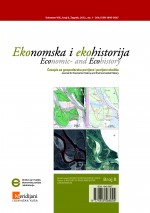Town planning of Zagreb 1862-1923 as a part of European cultural circle
Town planning of Zagreb 1862-1923 as a part of European cultural circle
Author(s): Mirela Slukan-AltićSubject(s): History
Published by: Društvo za hrvatsku ekonomsku povijest i ekohistoriju - Izdavačka kuća Meridijani
Keywords: history of town planning; 19th/20th century; Zagreb; Vienna; Budapest; Austro-Hungarian Monarchy
Summary/Abstract: Croatia was situated on the southern edge of the Habsburg Monarchy, thus the industrial revolution did not have a significant impact on the urban development of Croatian towns until the second half of the 19th century. The arrival of the railway in 1862 marked the beginning of a significant special growth of the town and its functional transformation. From 1865 until the period between the two world wars, a period of intensive town planning occurred and the city of Zagreb turned from a small Croatian administrative and trade centre into a modern industrial centre of south-eastern Europe. The town planning documents of Zagreb from 1865, 1887, 1905 and 1923 were concentrated around the establishment of a network of new streets and squares, the organisation of communal infrastructure, the shaping of the green areas and functional zoning of the town. All of this gave Zagreb’s Lower Town (Donji Grad) a recognisable middle-European urban identity. These processes were developed under the strong influence of European trends and town planning schools whose signatures can be clearly read in all of the projects of the Zagreb’s first town planning documents. The majority of Zagreb’s town planning experts of the time were educated in Vienna and Budapest. These cities became their main town planning pattern as so many of the town planning ideas applied in Vienna and Budapest can be recognised in the city of Zagreb. The second source of the European influence on Zagreb’s town planning came from the predominant town planning theories of Reinhard Baumeister and Camillo Sitte as well as from the basic town planning manual of the time – Der Städtebau by Josef Stübben, whose models of town building can be observed in numerous Zagreb’s streets and squares.
Journal: Ekonomska i ekohistorija - Časopis za gospodarsku povijest i povijest okoliša
- Issue Year: 2012
- Issue No: 8
- Page Range: 100-107
- Page Count: 8
- Language: English

